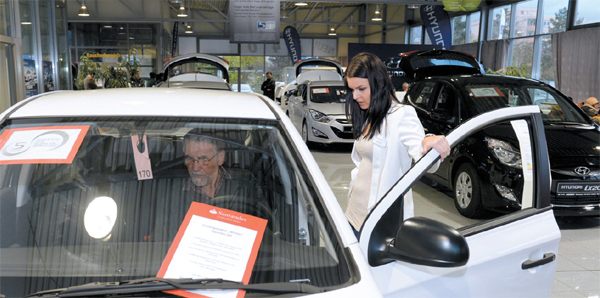Hyundai localization makes inroads in Europe

An employee at Autozentrum Goeres, a Hyundai dealership in Russelsheim, Germany, explains the i20 hatchback to a customer on Tuesday. Despite sluggish automobile demand in Europe, Hyundai and its Kia affiliate have seen impressive sales with their localized vehicles. Provided by the company
“The first year we sold Hyundai cars, our goal was to sell 120 vehicles, but we finished selling more than 200, and I experienced Hyundai’s possibilities,” says Goeres. “Now, we are selling more than 700 a year.”
Goeres believes Hyundai sales are growing steadily because his customers are no longer looking only for inexpensive cars. For example, he says, more people are asking about Hyundai’s midsize Santa Fe SUV.
His only complaint? Santa Fe buyers have to wait at least eight months for delivery.
Autozentrum Goeres has been in business since 1969, started by Goeres’ father, Alfred Goeres Sr. The business first sold Mazdas but switched to Hyundai in 2002. It was a good decision.
According to data from the European Automobile Manufacturers’ Association, Mazda sales in 2012 were 49 percent lower than in 2008. In contrast, Hyundai’s sales rose a whopping 60.1 percent over the same period, while its affiliate Kia Motors sales increased 41.4 percent. Hyundai and Kia’s performance is all more impressive as the European auto market shrank 14.9 percent from 2008 through 2012.
For the first nine months of this year, Hyundai’s pace slowed a bit to 327,907 units in Europe, down 1.6 percent year-on-year. However, the market shrank 4 percent.
Kia, Korea’s second-largest automaker, actually posted a sales increase of 0.3 percent to 258,545 units from January through September.
Hyundai Motor European Technical Center (HMETC) is also in Russelsheim, home to Opel. The center attributes progress by Hyundai and Kia to localizing the product lineup for European customers.
“The European market is a bit different than other places, because 75 percent of auto sales are in the A to C segments, in which hatchbacks and small SUV models account for 65 percent,” says Yang Seung-wook, vice president at the technical center. “European customers are sensitive about details, and in order to meet their preferences we have to care about everything from door handles to chrome inside the cabin.”

The i30 is still Hyundai’s most popular model, with 73,517 units sold in the first nine months of this year, followed by the ix35 compact SUV (Tucson in Korea) which sold 64,237 units. Accumulated i Series sales, including the i10 and i20, surpassed 1 million in June 2012.
Kia’s plan has been similar to Hyundai’s. After completion of its plant in Slovakia in 2007, the company started to produce Cee’d, the first model to be designed and developed for Europe. The company later added Venga, a small multipurpose vehicle (MPV), and the Rio hatchback (Pride in Korea).
For Hyundai and Kia, there seems to be no time to rest on their European laurels. Both were given another task by Hyundai Motor Group Chairman Chung Mong-koo during a visit last month: increase sales and brand value.
In markets like the United States and Korea, Chung has emphasized improving brand image and recognition, but for Europe, where automobile demand has been decreasing in the past five years, increasing sales is still important.
Achieving two goals simultaneously will not be easy, but Hyundai says the timing is right with the European market expected to bounce back next year. According to a report from the Korea Automotive Research Institute, demand in Europe is estimated to grow to 13.87 million units next year, up 2.5 percent from this year’s estimate.
Hyundai expects its new i10 will be the sales leader. The A segment car was reborn as the localized model for Europe because the latest edition was designed and developed entirely in Europe, while the production line was moved to Turkey from India.
For increasing brand value, the next-generation Genesis is on the way. Chung has especially high hopes for the full-size premium sedan that will be introduced in Europe next year. The chairman emphasized that the second-generation Genesis should serve as a foundation for Hyundai’s rise to a top-level brand in Europe and compete against Mercedes-Benz, BMW and Audi in the premium E segment.
“Our goal is to achieve market share of 5 percent and be a top five brand by 2020,” says Hwang Ki-young, general manager of sales for Hyundai Motor Europe.
Kia sees Chung’s order as an opportunity to grow rather than a challenge or task. European headquarters in Frankfurt says the company is ready to meet the goal.
“We have seen a transformation of the Kia brand in Europe,” says Michael Cole, chief operating officer of Kia Motors Europe. “We do not want to be a brand focusing only on price.”
Kia will first build sales with new models of the Cee’d, such as a three-door hatchback (Pro Cee’d), five-door station wagon (Cee’d SW) and high-performance version (Cee’d GT).
The company also has high hopes for the second-generation Soul, its compact MPV, reinforcing its brand image with sports marketing such as sponsoring tennis star Rafael Nadal and football events.
Cole says Kia Motors Europe will focus on increasing fleet sales, or sales to corporations. Currently, only a third of Kia vehicles are purchased by companies even though the European market is equally divided between private and fleet sales, according to Cole.
“It’s not as profitable as private customers, but we want to grow in the fleet market,” he says. “We also want to retain customers who have bought Kia vehicles. When they change cars, we want them to stay with the brand. We want them to buy a second Kia.”
BY JOO KYUNG-DON [kjoo@joongang.co.kr]










with the Korea JoongAng Daily
To write comments, please log in to one of the accounts.
Standards Board Policy (0/250자)